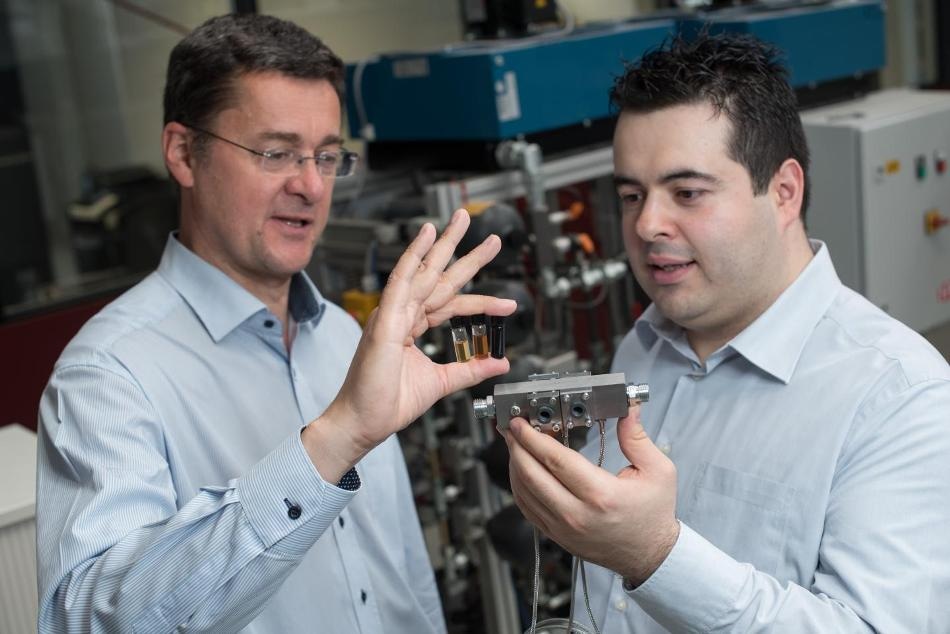Mar 31 2017
Thanks to a new sensor system developed collaboratively by Professor Andreas Schütze and his research team at Saarland University and a group of industrial project partners, unnecessary oil changes could well be a thing of the past. The new system can provide operators of combined heat and power plants with reliable continuous feedback on the current state of the oil. And the system can also warn the operator if the condition of the oil suddenly deteriorates. The oil flows through a small measuring cell where it is analysed spectroscopically to record the condition of the oil. The method offers numerous benefits: it is better for the environment, it lowers operating costs and it simplifies maintenance scheduling.
 Prof. Andreas Sch�tze (left) and Dipl.-Ing. Eliseo Pignanelli are showcasing a measuring system at Hannover Messe that continuously monitors oil quality and predicts when an oil change is required. The oil flows through the measuring cell where it is irradiated with infrared light. The oil samples in the bottles indicate how oil visibly ages: the bottle on the left contains new oil. (Credit: Oliver Dietze)
Prof. Andreas Sch�tze (left) and Dipl.-Ing. Eliseo Pignanelli are showcasing a measuring system at Hannover Messe that continuously monitors oil quality and predicts when an oil change is required. The oil flows through the measuring cell where it is irradiated with infrared light. The oil samples in the bottles indicate how oil visibly ages: the bottle on the left contains new oil. (Credit: Oliver Dietze)
The team of engineers will be presenting the system at Hannover Messe at the Saarland Research and Innovation Stand (Hall 2, Stand B46).
For an engine to survive it needs oil. Oil prevents an engine overheating and reduces friction and wear. But as time goes on, the oil deteriorates as it begins to oxidize. Water begins to accumulate in the oil and at some point the additives that help to maintain the oil's lubrication properties have been consumed. To avoid damaging the engine, the oil has to be changed. But when exactly has that point been reached? The problem up until now has been that the oil change point could only be determined precisely by regular laboratory examinations. For safety's sake, the oil in the engines of cars or CHP power plants is therefore changed at regular intervals, but in many of those cases the oil could have been used for longer. However, things now look set to change thanks to a new approach that is being showcased by Professor Andreas Schütze and his team at Hannover Messe.
'In our method we put a small measuring cell into the engine, through which oil flows while the engine is running. As a result, we can continuously monitor the quality of the oil and provide a running forecast of when the next oil change is likely to be due. This enables maintenance work to be scheduled more conveniently and it reliably eliminates the risk of expensive engine damage from a sudden deterioration in the condition of the oil,' explains Schütze.
The measuring cell continuously monitors the chemical composition of the oil. The oil is irradiated with infrared light, and the light that passes through the oil is detected. 'When the chemical make-up of the oil changes, so too does the spectrum of the infrared light that we detect. This enables us to infer the chemical condition of the oil, measure the degree of oxidation and determine whether water has entered the system,' explains Eliseo Pignanelli, a graduate engineer who helped to develop the method. The data from the measuring cell can be fed to the control system or remote monitoring system so that the engineering team can evaluate the data no matter where the plant or equipment is located.
Combined heat and power (CHP) plants generate electricity and heat locally at the site where they are needed and thus offer a way of supplying heat and power independently of the major distribution networks. Small-scale CHP plants find use in industry, schools, hospitals and even private homes. These mini cogeneration plants achieve a high level of efficiency. CHP plants can remove the need to transport energy - a process that never occurs without energy loss -- and any surplus electricity not used by the local consumer can be fed back into the public grid. The regular oil changes that have to be carried out in CHP plants have a negative impact both economically and environmentally. 'In gas-fired CHP plants, the oil is currently changed every 1500 operating hours, no matter whether strictly necessary or not. That is bad for the environment and also puts up plant operating costs -- a situation that can be avoided with our measuring system,' explains Andreas Schütze.
The Saarbrücken sensor system can be installed as a standard component in CHP plants. In addition to being fitted in cogeneration systems, the sensor system can also be installed in industrial plants, wind turbines, machinery or even used in mobile equipment. It is also suitable for monitoring other liquids.